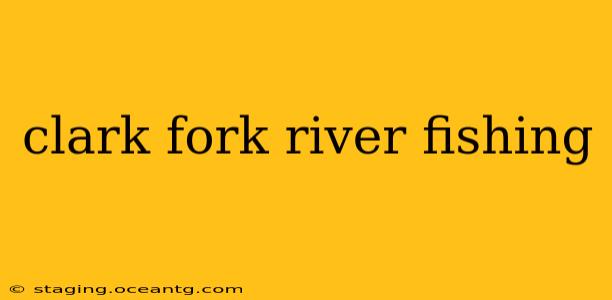The Clark Fork River, a major tributary of the Columbia River, offers anglers a diverse and rewarding fishing experience. From its headwaters in Montana to its confluence with the Columbia in Idaho, this river system boasts a variety of fish species and diverse habitats. This guide will delve into the intricacies of Clark Fork River fishing, providing valuable insights for both seasoned anglers and newcomers alike.
What species of fish can I catch in the Clark Fork River?
The Clark Fork River is home to a diverse range of fish species, making it a popular destination for anglers of all skill levels. Common catches include:
- Rainbow Trout: Abundant throughout much of the river, these vibrant trout provide exciting sport fishing opportunities.
- Brown Trout: Larger brown trout are often found in deeper pools and slower sections of the river.
- Cutthroat Trout: Native to the region, cutthroat trout are a prized catch for many anglers. Their presence varies depending on the specific section of the river.
- Bull Trout: These threatened species are found in specific areas of the river and require careful consideration of regulations. Check local regulations before targeting bull trout.
- Whitefish: Various species of whitefish can also be found in the Clark Fork, often providing a supplementary catch for anglers.
What are the best times of year to fish the Clark Fork River?
The best time to fish the Clark Fork River depends largely on the species you're targeting and the specific section of the river you're fishing. Generally:
- Spring: Spring runoff can make some sections of the river unfishable, but as the water clears, trout become active and feeding.
- Summer: Summer offers excellent opportunities for dry fly fishing, particularly for trout. However, water temperatures can rise, making certain areas less productive.
- Fall: Fall fishing can be excellent as the water cools and fish prepare for winter.
- Winter: Winter fishing can be productive, but access can be limited due to snow and ice in some areas.
Always check current water conditions and fishing reports before heading out.
What are the best fishing methods for the Clark Fork River?
The best fishing methods for the Clark Fork River vary depending on the time of year, water conditions, and the species you're targeting. Popular techniques include:
- Fly Fishing: A highly effective method, particularly during the summer months when dry flies are effective.
- Spin Fishing: Effective for targeting trout and other species with lures and spinners.
- Bait Fishing: While less popular among purists, bait fishing can be productive, particularly for less experienced anglers.
Where are the best places to fish on the Clark Fork River?
The Clark Fork River stretches for many miles, offering a wide variety of fishing locations. Identifying the best spot depends on your target species and preferred fishing methods. Local fishing guides and reports are invaluable resources for pinpointing productive areas. Researching specific access points and considering water flow are crucial steps in planning your fishing trip.
What are the fishing regulations for the Clark Fork River?
Fishing regulations on the Clark Fork River vary depending on the specific section of the river and the time of year. It is crucial to consult the Montana Fish, Wildlife & Parks (FWP) website or the Idaho Department of Fish and Game (IDFG) website, depending on the state you are fishing in, for the most up-to-date information on licenses, regulations, and bag limits. Failure to comply with regulations can result in fines.
What kind of gear do I need for fishing on the Clark Fork River?
The necessary gear depends on your preferred fishing method. However, generally, you will need:
- Fishing Rod and Reel: Choose appropriate gear for your target species and fishing method.
- Fishing Line: Select line appropriate for your rod and fishing method.
- Hooks, Lures, or Flies: Choose appropriate lures, flies, or bait based on your target species and fishing conditions.
- Waders (optional but recommended): Waders are highly recommended, particularly in the spring and fall when water levels may be higher.
- Appropriate Clothing: Dress in layers to adjust to changing weather conditions.
- Fishing License: Obtain the necessary fishing license from the relevant state agency before fishing.
This guide provides a starting point for planning your Clark Fork River fishing adventure. Remember to always respect the environment, practice catch-and-release when appropriate, and adhere to all fishing regulations. Enjoy the beauty and challenge of fishing this iconic river!
